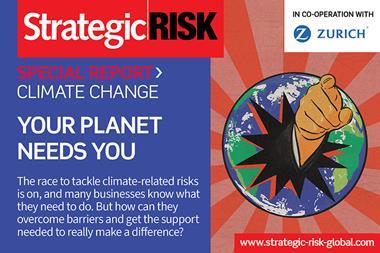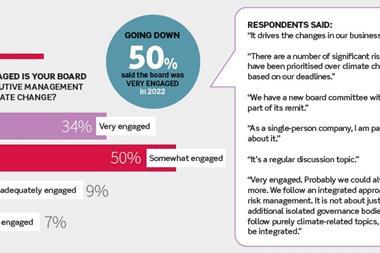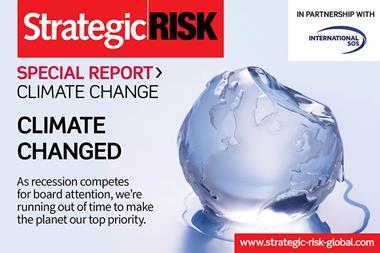New research shows world’s most climate vulnerable countries could lose over 100% of GDP in 2024 from disasters that are insurable
Vulnerable countries at risk from extreme climate shocks can be protected by the adoption of risk sharing systems, a new report published by Howden and the University of Cambridge has said.
Entitled Risk sharing for loss and damage: Scaling up protection for the Global South, the report highlighed that small countries across the Pacific, Caribbean and Indian Ocean currently face losses of between 50% and over 100% of annual gross domestic product (GDP).

And by 2050, climate change is expected to further increase those losses between 10% and 15% – equating to a 0.5% rise per year.
However, the report highlighted that these economies remain insurable and can be better protected with the use of systems that can enhance risk assessment.
“The pure maths and dispassionate economics in this analysis are clear,” Howden chief executive of climate risk and resilience Rowan Douglas said.
“Risk sharing systems empower hard won loss and damage funds to provide structural financial security to the widest range of vulnerable countries. We can mobilise existing expertise, institutions and partnerships to put this essential protection in place quickly.”
Key findings from the report:
- The research quantified the losses faced by small, climate vulnerable countries across the Pacific, Caribbean and Indian Ocean. Today, these countries face foreseeable losses of between 50% and over 100% of annual GDP from extreme climate events, such as severe droughts, tropical cyclones and floods. By 2050 losses are set to grow between 10-15% due to climate change alone, approximately 0.5% per year.
- Despite the growing risks, modelling by the researchers revealed that these economies remain insurable. Under the proposed plan, an estimated $1 billion of donor-supported annual pure premium could protect all 30 of the world’s smallest and most climate vulnerable countries with a population of less than one million from losing more than 10% of their GDP from climate shocks; through a risk sharing mechanism known as “Umbrella Stop-Loss Protection”.
- Despite growing risks from extreme climate events, the study reveals that this protection could be maintained through to 2050 and beyond, providing these countries with the necessary financial security to plan with confidence, attract investment, and make more informed decisions around resilient development and climate change adaptation.
- A donor-supported annual pure premium of $10m per country equates to approximately $25bn of financial protection, contractually guaranteed, across 100 countries. This provides, for each of these countries, significant pre-arranged finance protection to support their highest priority needs.
Loss and Damage (L&D)
In the report, the researchers suggested that 30 of the world’s smallest and most climate vulnerable countries could be protected from losing 10% of GDP by an estimated $1bn (£826.4m) of donor-supported annual pure premium through a risk sharing mechanism.
This is known as umbrella stop-loss protection, which means all defined losses above a given threshold are protected.
The threshold of 10% was chosen by the researchers because they believe it provided significant protection while, at the same time, remained affordable to donors.
And the University of Cambridge Institute for Sustainable Leadership (CISL) stated the protection could be maintained through to 2050, with the results illustrating how risk sharing can be scaled up to form the pillar of a loss and damage (L&D) solution.
Howden and CISL also said the report “provides a clear pathway to L&D implementation to inform high level discussions on the deployment of L&D funds” as world leaders prepare for COP28.
Dr Ana Gonzalez Pelaez, fellow, CISL, and lead author comments: “We have demonstrated how public-private finance can be combined to protect billions of people, now and in the decades ahead. We are calling on the international community to make risk-sharing systems a pillar of the Loss and Damage architecture for all countries and introduce umbrella stop-loss mechanisms to protect the economies of the world’s smallest and most climate-vulnerable countries.
“The action plan presented in this study is ready and can be implemented using existing institutions to provide vulnerable countries with guaranteed payouts from the risk capital markets after a disaster. These funds could be used for critical priorities such as humanitarian assistance; rebuilding schools, hospitals and vital infrastructure; sovereign debt repayments; restoration of agriculture and ecosystems.”
COP28
COP28 will take place in Dubai from 30 November to 12 December 2023.
However, the report stated that ”regardless of where negotiated outcomes on L&D settle at COP28, private sector innovation will be needed to apply donor funds in the most efficient, effective way to enable vulnerable nations to prepare financially for the future”.
And CISL fellow and research lead author Ana Gonzalez Pelaez called on the international community ”to make risk-sharing systems a pillar of the L&D architecture for all countries and introduce umbrella stop-loss mechanisms to protect the economies of the world’s smallest and most climate-vulnerable countries”.
“We have demonstrated how public-private finance can be combined to protect billions of people, now and in the decades ahead,” she added.
“The action plan presented in this study is ready and can be implemented using existing institutions to provide vulnerable countries with guaranteed payouts from the risk capital markets after a disaster.”
- We have converted dollar amounts into pounds using an exchange rate of $1.21 = £1, which was correct as of 1 November 2023.




















No comments yet